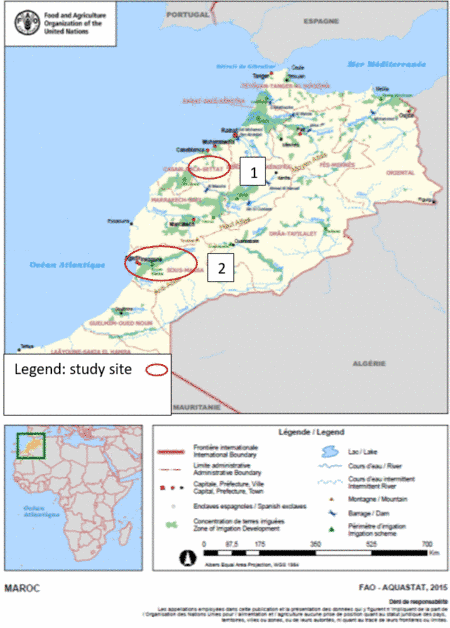Background and sites
Morocco, a North West African country on the Mediterranean Coast host 33 million inhabitants. The cultivated area (annual and permanent crops) is estimated at 9.4 million hectares in 2012. The forest estate covers 9 million hectares, of which around 5.1 million hectares are forested. Agriculture share in GDP represents 14.6 percent of total GDP in 2012. However, its contribution to GDP and the GDP itself suffered significant fluctuations due to climatic hazards. The agricultural sector contributes to exports up to 10.5 percent and rural incomes up to 65 percent. It employs 23.5 percent of the active population at the national level, but it remains dominant in rural areas where the share of the active population not in farming is still very low.
Water plays a critical role to cope with variability and scarcity. The total renewable water resources are estimated to be 29 km3/year with 2/3 surface water –irregularly distributed on the territory- and 1/3 groundwater. Only 22 km2/year are considered technically manageable. In 2010, water withdrawals amounted to 10,580 million m3 of which 2,322 million m3 of groundwater, 7 million m3 of desalinated water and 8,251 million m3 of surface water, to which must be added 70 million m3 of treated wastewater used directly. However, the water demands for the year 2010 amounted to 14,649 million m3, of which 90 percent for irrigation. The confrontation between water resources mobilized and the water demands of the different sectors shows that the needs are not met and that there is a water deficit that is partially covered by groundwater over-exploitation. In particular, irrigation water needs are not completely satisfied, thus reducing agricultural production in the areas equipped.
In 2017, within the framework of the joint program of the FAO and the Moroccan government piloted the Sustainable food and Agriculture framework" (SFA). The SFA-Morocco diagnostic study, validated and published in 2017, identified priority issues/objectives for the sustainability of agriculture in Morocco. A downscaling of the analysis was done at regional level in Souss Massa that enabled to gather field evidence on some of the key issues identified. The dialogue organized on October 31, 2017 debated the preliminary elements of a study commissioned to a national team to check the policies and their instruments from the point of view of their combined effects on water. Among the recommendations were the importance to assess the sustainability of the water use in agriculture in the framework of a Nexus analysis, assess the reality of groundwater exploitation and the sectors of use.
Project in the country
In Morocco, the project works on the following outputs: (i) water accounting: Adoption of international standards and scientifically sound ‘water accounting systems’ based on Remote Sensing (RS); and (ii) WP- increasing water irrigation efficiency and productivity, (iii) informing strategic planning and trade-offs decisions through a Nexus approach-water-agriculture-energy. The project works in different sites of the country for the different outputs. Further details on partners/team, related events and key results.
The main activities implemented in Morocco under the three outputs are:
1) Water accounting - Setting sustainable limits of water consumption
a) knowing cropping realities- - crop mapping patterns to assess crop evapotranspiration and water productivity;
b) measuring and validating Evapotranspiration( ET) – increasing certainties on crop evapotranspiration (crop ET); piloting ET monitoring for the RNA ET network;
c) learning by doing water accounting & auditing – understanding the water scarcity situation, its causes and trends.
2) Water efficiency and productivity- Making the best use of every drop of water in agriculture
a) national baseline on water productivity (literature review);
b) site level water productivity assessment to understand opportunities for
improvement (farmer survey);
c) Farmers experimentation on water productivity using the Farmer field school approach;
d) gender, social inclusion and decentralized governance;
e) water productivity along sustainable and gender sensitive value chain and reducing food loss and waste.
3) Nexus water-food-energy
a) sectoral (water, agriculture, energy) and intersectoral analysis
b) participatory nexus dialogue to assess the issues, the vulnerability, develop scenarios
c) development of an integrated nexus model
Project Sites
Building on past assessments, the project activities focus on the Berrechid-Chaouia region, and the Souss Massa region. The Berrechid-Chaouia region south of Casablanca used to be an important rainfed area but has seen in the last 10 years a boom of irrigated horticulture and particularly carrot production. This is leading to a fast drop in groundwater. The Souss Massa region is the main agricultural center of the country and the source of most of the agricultural expert. This has been at the expense of its aquifers. Agricultural water demand is reaching a limit in those sites and coming at a very high energy, social and environmental cost.
1. Benslimane / Berrechid (Region of Casablanca- Settat)
2. Region of Souss-Massa

